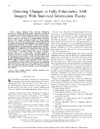Identificador persistente para citar o vincular este elemento:
https://accedacris.ulpgc.es/jspui/handle/10553/50286
| Campo DC | Valor | idioma |
|---|---|---|
| dc.contributor.author | Nascimento, Abraao D.C. | en_US |
| dc.contributor.author | Frery, Alejandro C. | en_US |
| dc.contributor.author | Cintra, Renato J. | en_US |
| dc.date.accessioned | 2018-11-24T14:52:24Z | - |
| dc.date.available | 2018-11-24T14:52:24Z | - |
| dc.date.issued | 2019 | en_US |
| dc.identifier.issn | 0196-2892 | en_US |
| dc.identifier.uri | https://accedacris.ulpgc.es/handle/10553/50286 | - |
| dc.description.abstract | Images obtained from coherent illumination processes are contaminated with speckle. A prominent example of such imagery systems is the polarimetric synthetic aperture radar (PolSAR). For such a remote sensing tool, the speckle interference pattern appears in the form of a positive-definite Hermitian matrix, which requires specialized models and makes change detection a hard task. The scaled complex Wishart distribution is a widely used model for PolSAR images. Such a distribution is defined by two parameters: the number of looks and the complex covariance matrix. The last parameter contains all the necessary information to characterize the backscattered data, and thus, identifying changes in a sequence of images can be formulated as a problem of verifying whether the complex covariance matrices differ at two or more takes. This paper proposes a comparison between a classical change detection method based on the likelihood ratio and three statistical methods that depend on information-theoretic measures: the Kullback-Leibler (KL) distance and two entropies. The performance of these four tests was quantified in terms of their sample test powers and sizes using simulated data. The tests are then applied to actual PolSAR data. The results provide evidence that tests based on entropies may outperform those based on the KL distance and likelihood ratio statistics. | en_US |
| dc.language | eng | en_US |
| dc.publisher | 0196-2892 | |
| dc.relation.ispartof | IEEE Transactions on Geoscience and Remote Sensing | en_US |
| dc.source | IEEE Transactions on Geoscience and Remote Sensing [ISSN 0196-2892], v. 57(3), p. 1380-1392 | en_US |
| dc.subject | 3325 Tecnología de las telecomunicaciones | en_US |
| dc.subject.other | Change detection | en_US |
| dc.subject.other | Contrast | en_US |
| dc.subject.other | Hypothesis test | en_US |
| dc.subject.other | Information theory | en_US |
| dc.subject.other | Wishart | en_US |
| dc.title | Detecting Changes in Fully Polarimetric SAR Imagery With Statistical Information Theory | en_US |
| dc.type | info:eu-repo/semantics/article | en_US |
| dc.type | Article | en_US |
| dc.identifier.doi | 10.1109/TGRS.2018.2866367 | en_US |
| dc.identifier.scopus | 85053294208 | - |
| dc.contributor.authorscopusid | 35264620800 | - |
| dc.contributor.authorscopusid | 7003561251 | - |
| dc.contributor.authorscopusid | 55930266600 | - |
| dc.investigacion | Ingeniería y Arquitectura | en_US |
| dc.type2 | Artículo | en_US |
| dc.utils.revision | Sí | en_US |
| dc.identifier.ulpgc | Sí | en_US |
| dc.contributor.buulpgc | BU-ING | en_US |
| dc.description.sjr | 2,616 | |
| dc.description.jcr | 5,855 | |
| dc.description.sjrq | Q1 | |
| dc.description.jcrq | Q1 | |
| dc.description.scie | SCIE | |
| item.fulltext | Con texto completo | - |
| item.grantfulltext | open | - |
| crisitem.author.orcid | 0000-0002-8002-5341 | - |
| crisitem.author.fullName | C. Frery, Alejandro | - |
| Colección: | Artículos | |
Citas SCOPUSTM
56
actualizado el 08-jun-2025
Citas de WEB OF SCIENCETM
Citations
44
actualizado el 08-jun-2025
Visitas
50
actualizado el 15-jun-2024
Descargas
391
actualizado el 15-jun-2024
Google ScholarTM
Verifica
Altmetric
Comparte
Exporta metadatos
Los elementos en ULPGC accedaCRIS están protegidos por derechos de autor con todos los derechos reservados, a menos que se indique lo contrario.
